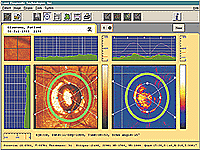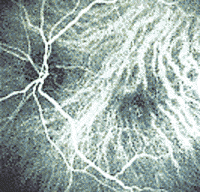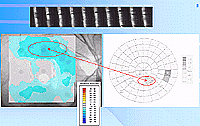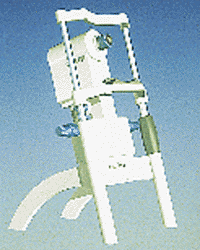New technology looks beyond visual ability to the site of damage
Click Here to Manage Email Alerts
Nerve fiber layer (NFL) and optic nerve head analysis may never completely replace visual field and intraocular pressure testing as the primary means of diagnosing and managing glaucoma. However, these systems are gaining popularity among glaucoma specialists and patients because of their ability to look beyond symptoms and focus on actual damage.
Physicians and patients like the systems for much the same reason: they work quickly, often capturing all the data needed in less than a second. Clinicians note that NFL and nerve head results are not subject to the potentially inconsistent responses that cloud results when patients become fatigued. They also note that NFL and nerve head analyses tend to be more accurate because they take measurements at the site of the glaucoma damage rather than merely studying the symptoms of the disease. Additionally, because a current procedural terminology (CPT) code has been provided for this technology, practitioners are able to bill the Health Care Financing Administration for the procedure.
Patients also prefer the newer methods of glaucoma analysis to visual field perimetry testing because they are no longer asked to endure tedious and somewhat uncomfortable sessions in front of a brightly illuminated, small monitor in a darkened room.
Currently, the nerve fiber layer and optic nerve head analysis systems available to clinicians include the GDx Nerve Fiber Analyzer and TopSS Topographic Scanning System from Laser Diagnostics Technologies Inc., Heidelberg Engineering's Heidelberg Retina Tomograph, Humphrey Systems’ Zeiss Optical Coherence Tomography Scanner and Dicon’s Retinal Thickness Analyzer.
The basic idea behind all of these systems is the same: damage is measured by comparing the relative thickness of a patient’s nerve fiber layer, or damage to the optic nerve head, and then comparing those measurements to data that have been compiled in a normative base.
Quantitative measurement
The development of NFL analysis technology allows for more than the crude, almost subjective methods of measuring the retina, such as using different wavelengths of light or polarizing filters, said Bert M. Glaser, MD, co-founder of the Glaser Murphy Retina Treatment Center, in an interview with Primary Care Optometry News.
Mark Latina, MD, a glaucoma specialist affiliated with the Massachusetts Eye and Ear Infirmary and Tufts University in Boston, agreed. “The big advantage to these new systems is that they provide a quantitative measure of nerve fiber layer and optic disc changes that can occur in glaucoma,” he said. “These quantitative measures can then be used as baselines to follow patients and are potentially more accurate over a long period of time. We hope this technology will allow us to detect anatomic changes nonsubjectively and earlier.”
Measuring glaucomatous damage at the point of injury, rather than just how those injuries manifest themselves in the visual field, may give physicians a better understanding of how glaucoma affects vision and a better idea of how to treat it. As the collective normative database grows and specialists learn more about how damage to the NFL or optic nerve head corresponds with visual impairment, they also better understand how to apply neuroprotective drugs, considered the future of glaucoma management.
“Nerve fiber analysis is enormously useful and should be used as much as possible to better understand these complicated diseases,” Dr. Glaser said. “I’m sure we can track a lot of diseases we haven’t even thought about. Any disease that affects the inner retina is going to have some effect on the nerve fiber layer. There may be clues that detect disease before we normally do. It will be interesting to see what happens to the nerve fiber layer of diabetics and those with venous occlusive diseases.”
GDx: both eyes in less than 3 minutes
 ---The GDx scan of a patient with advanced glaucoma indicates a loss of retinal nerve fiber layer, as shown by the absence of colors in the thickness map.
---The GDx scan of a patient with advanced glaucoma indicates a loss of retinal nerve fiber layer, as shown by the absence of colors in the thickness map.
The GDx provides physicians accurate answers in less than 3 minutes for both eyes and does not require that the patient’s eyes be dilated. Results are automatically compared to normative data then displayed on screen or printed. Because the system works so quickly, Laser Diagnostic Technologies Inc. (LDT) says that physicians can use the system for screening all at-risk patients rather than just those considered glaucoma suspects.
In patients with glaucoma or ocular hypertension, the GDx measures the degree of damage that elevated pressure has exacted on the retinal NFL. Because 30% to 50% of nerve fiber damage occurs before defects are apparent in the visual field, the GDx can be a valuable tool in the early diagnosis of disease.
A printout of GDx results provides indicators of the status of the retinal nerve fiber layer, providing the clinician with a fundus image of the patient’s eye, a color-coded thickness map of the NFL and a detailed comparison to the age- and race-matched normative database.
TopSS: a less costly alternative
 ---The high-speed indocyanine green images produced by the Heidelberg Retina Angiograph allow practitioners to detect feeder vessels earlier in the disease process, making treatment more effective.
---The high-speed indocyanine green images produced by the Heidelberg Retina Angiograph allow practitioners to detect feeder vessels earlier in the disease process, making treatment more effective.
In addition to the GDx, LDT manufactures a scanning laser tomograph called the TopSS XL-2020.
The XL-2020 is marketed by LDT as a “complete and sophisticated confocal scanning laser,” according to the company. Like the HRT, TopSS is a multipurpose tomograph for imaging and measuring retinal topography, allowing clinicians to image and track changes of the optic nerve head, macular holes, tumors and edema. TopSS can evaluate the topography of the nerve fiber layer, but does not make specific thickness measurements like the GDx.
The system offers multiple scan ranges and selectable placement of the topographic image series so a clinician can maximize depth resolution for the retinal feature being observed. Three field choices allow for good lateral resolution, while the system’s internal and external fixation lights provide the patient with comfort and the clinician with the flexibility needed for a thorough examination.
RTA: fast acquisition
 ---The Retinal Thickness Analyzer can detect glaucomatous damage by measuring changes in the thickness of the nerve fiber layer.
---The Retinal Thickness Analyzer can detect glaucomatous damage by measuring changes in the thickness of the nerve fiber layer.
Introduced this year, the Retinal Thickness Analyzer (RTA) from Dicon operates on the same optical principle as a slit lamp, but with a green laser as the scanning light source. The laser scans a 2 x 2-mm section of the retina, and the acquisition time for each scan is approximately 200 ms, according to Michael McKay, Retinal Thickness Analyzer product manager for Dicon. “The rapid scans as well as the ability to measure the entire retina and the optic disc make the RTA a very versatile instrument,” he said.
The RTA has primarily been used to follow patients with diabetic macular edema at the retinal clinic at The New York Eye and Ear Infirmary.
Richard B. Rosen, MD, director of residency training, told Primary Care Optometry News: “In terms of uses for diabetics, it provides a good quantitative recording of the retinal topography, particularly detailing areas of clinically significant macular edema, which we’ve found to be in very good correlation to clinical observations by trained observers.”
The Eye and Ear Infirmary also participated in a study where the RTA was used as a screening tool. The level of detail it provides shows very early changes in the macula, which would allow earlier intervention in cases of diabetic retinopathy and glaucoma.
Currently the RTA overlays scans on the fundus image with 2-D and 3-D color maps. Plans are underway to overlay information in Dicon’s Fieldview perimetry software. Custom designed visual field tests could be computer designed to only look at certain areas of concern, Mr. McKay said. The perimeter will perform a standard visual test but will increase the density of points in specific areas.
Scanning laser ophthalmoscopy
 ---The Heidelberg Retina Tomograph II. due out later this year, features automatic acquisition and progression analysis, and is capable of being operated off a laptop computer, making it a more portable system.
---The Heidelberg Retina Tomograph II. due out later this year, features automatic acquisition and progression analysis, and is capable of being operated off a laptop computer, making it a more portable system.
When coupled with angiography, scanning laser ophthalmoscopy gave practitioners the ability to perform high-speed angiograms, which has resulted in detecting problems much earlier in the disease process, Dr. Glaser said.
“Changes to the choroid occur even more rapidly, and the dynamic seems to be even more important in the choroid than those same parameters are in retinal circulation. Choroidal blood flow is very rapid, and flow patterns change throughout the time the dye transits the vascular bed. The scanning laser ophthalmoscope gives you the ability to track these things rapidly and with high resolution,” Dr. Glaser said.
This feature has been particularly valuable in detecting feeder vessels in cases of choroidal neovascularization. Practitioners are now able to detect them in about 90% of cases with age-related macular degeneration, he said. When the feeder vessels are located, they can be treated with a pinpoint laser instead of a broad laser, reducing the damage to the healthy surrounding tissue.
HRT: calculates NFL thickness
 ---Optical Coherence Tomography Scanner: This fundus view of a normal eye with a linear OCT scan was taken through the fovea and optic disc. The OCT scan depicts the cross-sectional view of the fovea and optic disc.
---Optical Coherence Tomography Scanner: This fundus view of a normal eye with a linear OCT scan was taken through the fovea and optic disc. The OCT scan depicts the cross-sectional view of the fovea and optic disc.
The Heidelberg Retina Tomograph (HRT) is a confocal laser scanning system microscope designed for acquiring and analyzing 3-D images of both the retinal nerve fiber layer and the optic nerve head.
Analysis of the optic nerve head is considered the most accurate and sensitive method for assessing the damage caused by glaucoma. Retinal tomography allows for quantitative assessment of the topography of ocular structures and the precise follow-up of topographic changes. While it has retinal and blood flow assessment applications, the Heidelberg system’s most important clinical application is perhaps its ability to provide topographic description and follow-up of the glaucomatous optic nerve head and calculation of NFL thickness.
The goal of optic nerve head topography is either a quantitative description and classification of the optic nerve head’s current state or a comparison of past topographic images to assess the state and rate of disease progression. The HRT can assess the optic nerve head two ways: with interactive measurements, which compare heights and distances between structures from exam to exam, and with parametric description, or determinations based on a set of stereometric parameters.
In a clinical study that used linear regression between optic disc area and log of the neural retinal rim area, the HRT has been shown to detect glaucoma earlier in suspect patients, with high specificity and sensitivity values.
“This system is valuable because it allows analysis of both the NFL and the optic disc,” said Dr. Latina, who uses both a GDx and an HRT. “The HRT offers a significant amount of information that can be tracked over time.”
Later this year, Heidelberg will be releasing a smaller, automated version, the HRT II, at a substantially reduced price, according to the company.
OCT: strong resolution
The Zeiss Optical Coherence Tomography (OCT) Scanner from Humphrey provides a cross-sectional scan of underlying structures not directly observable by any other diagnostic means, which allows for earlier confirmation of damage and initiation of treatment. The system’s resolution of between 10 µm and 17 µm makes highly accurate depictions possible.
The system is noncontact and noninvasive, requires dilation drops only if the pupil is less than 5 mm in diameter and does not use high-intensity light to measure the field. The OCT increases the comfort level of the patient and reduces photophobia. Complete data collection takes about 1 second.
The OCT features a multiple document screen that permits side-by-side comparison of scans and shows red-free fundus images and numerical data.
Complements, not replacements
While the new technology offers clinicians an insight to glaucoma and retinal damage that was previously left to deduction or guesswork, none are likely to replace conventional field tests, because each patient is different.
“They all have a role, and I think they have the ability to provide additional data regarding complex retinal disorders that are vision threatening and, thus, threaten the quality of life. I don’t think they will replace the older methods, but they will augment them significantly,” Dr. Glaser said.
“You need to look at as many parameters as possible to evaluate each patient,” Dr. Latina said. “I don’t think anyone should rely on any single parameter. The companies would need to come up with a highly specific parameter before this type of technology will replace the conventional methods. But we always examine several parameters. If we only looked at pressure, for example, we would miss detecting many patients with glaucoma. We know the same symptoms affect individuals differently.”
One of the shortcomings of these new devices, as with any new technology, is the limited normative databases doctors will need to interpret the results of individual patients. This is one reason every effort should be made to get them into the hands of practitioners, Dr. Glaser said.
“You’ll never get to that level unless more doctors in general practice in ophthalmology and optometry have it and use it,” he said. “No academic institution could hope to have enough data in a quick enough time to suit our needs to be able to do it all.” The more practitioners who have access to the new technology, the more valuable the technology will become, Dr. Glaser said.
“Right now, much of this equipment resides in research institutions, and there are just not enough of them to be able to learn what we really need to learn,” he continued. “Most of the time, the great strides have not been made until innovations get out into the general clinical community. With all fairness to academic institutions, we can’t hope to have the kind of manpower and diversity of thought to fully use and develop these types of new techniques until they are available to the general ophthalmic and optometric communities.”
For Your Information:
- Bert M. Glaser, MD, can be reached at 5530 Wisconsin Ave., Ste. 835, Chevy Chase, MD 20815; (301) 986-8747; fax: (301) 986-8944. Dr. Glaser has no direct financial interest in the products mentioned in this article, nor is he a paid consultant for any companies mentioned.
- Mark Latina, MD, can be reached at Reading Health Center, Ste. 204, 20 Pond Meadow Drive, Reading, MA 01867; (781) 942-9876; fax: (781) 942-9877. Dr. Latina has no direct financial interest in the products mentioned in this article, nor is he a paid consultant for any companies mentioned.
- Michael McKay is product manager for the Dicon Retinal Thickness Analyzer. He can be contacted at PO Box 3399, Placida, FL 33946; (800) 214-2030; fax: (941) 698-7583.
- Richard B. Rosen, MD, can be reached at The New York Eye and Ear Infirmary, 310 E. 14th St., #319, New York, NY 10003; (212) 979-4495 ; fax: (212) 979-4268. Dr. Rosen has no direct financial interest in the products mentioned in this article, nor is he a paid consultant for any companies mentioned.
- The GDx Nerve Fiber Analyzer and TopSS Topographic Scanning System are available from Laser Diagnostic Technologies, 9550 Waples St., Ste. 105, San Diego, CA 92121; (858) 558-9144; (800) 722-6393; fax: (858) 558-9145; Web site: www.laserdiagnostic.com.
- The Heidelberg Retina Tomograph, the Heidelberg Retina Tomograph II and the Heidelberg Retina Angiograph are available from Heidelberg Engineering Inc., 5661 Palmer Way, Ste. G, Carlsbad, CA 92008; (760) 930-3570; fax: (760) 930-3575.
- The Zeiss Optical Coherence Tomography Scanner is available from Humphrey Systems, 5160 Hacienda Dr., Dublin, CA 94568; (877) 486-7473; fax: (925) 557-4319; Web site: www.humphrey.com.
- The Retinal Thickness Analyzer is available from Dicon, 10373 Roselle St., Ste. 4, San Diego, CA 92121; (800) 426-0493; fax: (619) 554-0332.
